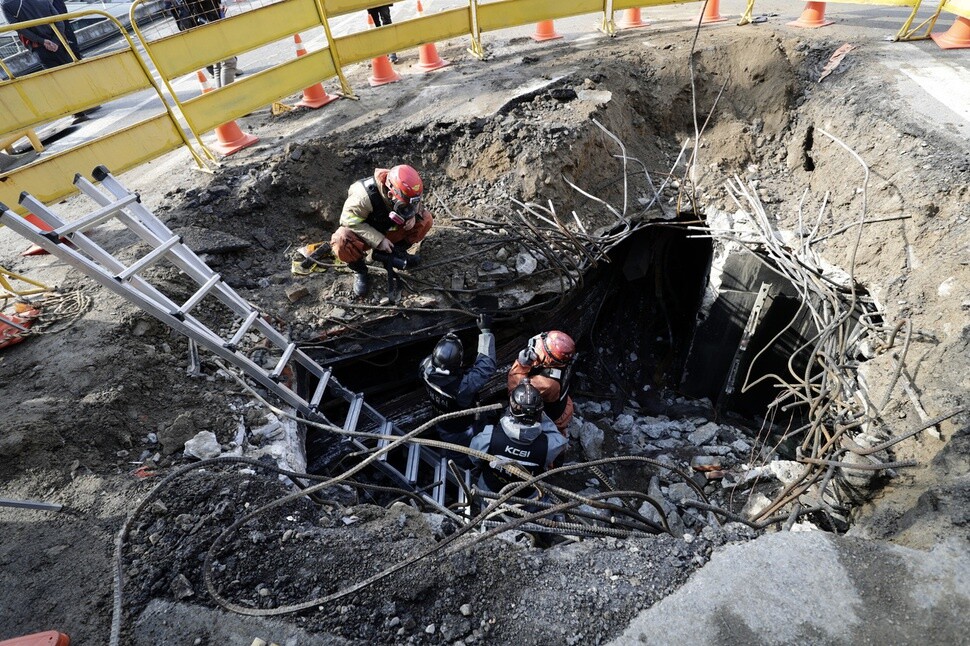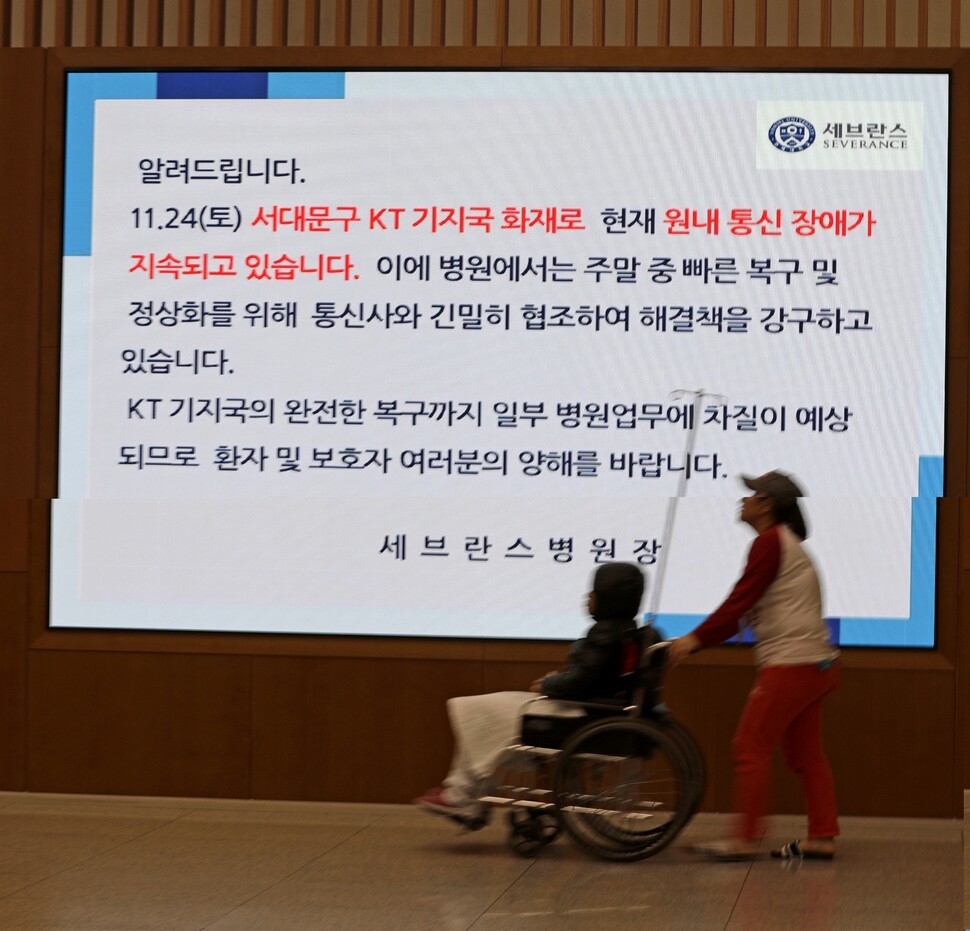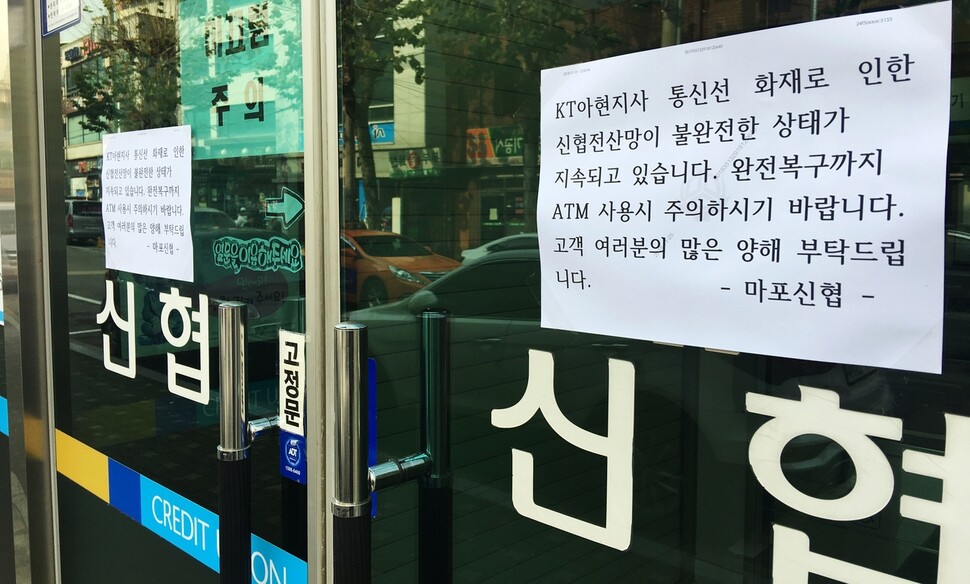hankyoreh
Links to other country sites 다른 나라 사이트 링크
Disaster at S. Korean telecommunications giant exposes weakness of “superconnected” society

“This episode is a textbook example of a risk society.”
One of South Korea’s pressure points as an IT power boasting “the world’s top 5G technology” was starkly exposed when a fire broke out in an underground cable tunnel conduit in central Seoul. The resulting collapse in the KT communications network plunged the telecom giant’s users into the “dark ages” of communications, severing network access to over 210,000 households using mobile, cable internet, and IPTV services. Various 112 (emergency telephone number like 911 in the US) systems at police stations near the scene of the fire were temporarily paralyzed, as were hospital computer networks and electronic security systems. The chaos also affected restaurants and convenience stores, which lost access to credit card transaction and telephone order systems.

Erupting in the heart of a city that has become “superconnected” as a result of information and communications technology, the situation also left government authorities helpless to share their disaster notification text services with the residents who needed them most.
According to an explanation from Seoul Seodaemun Fire Station on Nov. 25, the fire broke out at around 11:13 am the day before in an optical cable in an underground tunnel at KT’s Ahyeon branch on Chungjeong Road in Seoul’s Seodaemun district. Over 200 firefighters and police and 70 pieces of equipment were used to bring the fire under control; it was finally extinguished completely at around 9:26 pm. In response to the impaired communications, KT replaced its mobile telephone network with an older 3G model – but the resulting deluge of users further prevented smooth communication.

The system that revealed the most serious flaws after the fire’s eruption was the disaster information text messaging service. KT network users in the districts of Seodaemun, Mapo, Jung (Central), and Yongsan temporarily lost any means of contacting the outside. At around 12:05 pm on Nov. 24, the Seoul Disaster Safety Headquarters and Seodaemun District Office began sending out a series of disaster information texts. These were duly received by SKT and LGU+ users unaffected by the impaired communications – but did not reach KT users. As a result, many KT users said they were unaware what was happening with their communications until late in the afternoon.
“I was in my neighborhood all day on Nov. 24, and I never received any disaster information messages,” said Park Jeong-in, a 23-year-old company employee who lives in the Sangam neighborhood of Mapo District.
“KT subscribers could only get information about the disaster from subscribers at other telecoms, which made me question whether this wasn’t just another ‘fake news’ story,” Park added.
The 112 system at nearby police stations in Seodaemun was also left temporarily down. According to a National Police Agency (NPA) announcement on Nov. 25, security and general telephone and 112 systems at Yongsan Police Station were left non-operational from the time the fire broke out at 11:13 am until around 2:10 pm the following day. Employees with the Yongsan Police Station’s 112 situation room had to be dispatched to the NPA 112 situation room to relay the situation by radio.
At Seodaemun Police Station, regular telephone service was knocked out, while the 112 system remained out of service until 8 am on Nov. 25. Security and general telephone services were also left non-operational at Mapo Police Station, as well as security and general telephone services and the 112 system at Namdaemun Police Station’s Jungrim police box. As of now, there is no way of determining whether any emergency crime reports or rescue requests were sent to those stations during the outage.
Hospital computer networks, electronic security systems also paralyzed
The chaos spilled over to hospitals as internet-based computer networks were knocked out. Medical staff using KT phones could not be paged during emergencies, resulting in a touch-and-go situation as personnel had to be located through the hospital PA system.
“For 24 hours, the internet outage has prevented us from contacting the National Health Insurance Service system, resulting in delays in checking whether visiting patients were enrolled,” reported Yonsei University Severance Hospital, which is located in Seoul’s Sinchon neighborhood.
“As of Nov. 25, the internet had been restored, but we are still experiencing problems with some telephone connections,” the hospital added.
Small merchants were left on edge throughout the weekend as electronic security systems were left paralyzed.
“We use the KT Telecop electronic security system, and the CCTV recording and fingerprint-based locking devices were nonfunctional all day on Nov. 24 and weren’t back to normal until after 9 pm,” said Han Seon-jeong, 25, who manages a clothing store near Hongik University.
“As a clothing store, we use CCTV to address the theft issue. I was so nervous I couldn’t focus on my work,” Han complained.
KT users were left anxious amid the information vacuum resulting from the disruption of telephone, internet, and even television services.
“I use KT for my phone, TV, and internet, and I spent all day on Nov. 24 completely cut off from the world,” said a 42-year-old KT user surnamed Park who lives in the Bukgajwa neighborhood of Seodaemun.
“It was a fear I’ve never experienced before, being unable to access any information,” Park said.
A 26-year-old Sinchon resident surnamed Cheon said, “From about 11 am on Nov. 24, I couldn’t make any calls or use text messages or the internet, and because of the communications issues I couldn’t even buy things at the convenience store.”
Before eventually leaving the Seodaemun area, Cheon could only watch a mobile phone screen message reading “Searching for a frequency. Emergency calling only.”

An unusual spectacle also unfolded as residents lined up to use public telephone booths at main streets near Hongik University and Sinchon stations on Line 2 of the Seoul Subway. It was a last-ditch strategy for many who had plans to meet with people over the weekend but knew only the general location and time. Customers were also seen paying in cash or through bank transfers at cafés, restaurants, and shopping malls where credit card transaction systems had been knocked out.
Thanks to lifestyle patterns where everything is tailored to smartphones, residents faced inconveniences in unexpected places.
“I was supposed to go to an event scheduled near Hongik University Station by 1 pm, but I couldn’t find the precise location because my smartphone map app wasn’t working,” explained a 35-year-old surnamed Kim who lives in the Galhyeon neighborhood in Seoul’s Eunpyeong district.
“I had to wander around looking for it, and while I finally got there, I found that the only people who had arrived on time were SK Telecom users,” Kim said.
Delivery services faced major hassles as well.
“Delivery drivers who use KT can’t work at all [under these circumstances]. On Nov. 24, about 20–30% of our drivers couldn’t work and ended up going home,” said a source with the Yongsan branch of the delivery service Barogo.
“We typically make the most money on weekends, so with this happening on a Saturday of all days, it was a pretty big blow to sales,” the source added.
“Some of the restaurants are still calling me on my personal phone to get in touch with the drivers because they can’t take telephone orders.”

“Textbook example of a risk society”
The KT situation offered a stark portrait of IT in South Korea today: focused exclusively on convenience and consumption, but with the potential to be left utterly incapacitated in situations that impact residents’ survival and livelihood. Seong Sang-won, author of the book “How to Survive Almost Any Disaster,” said the episode “would not have happened if government agencies and telecoms had established the necessary communications network for a worst-case disaster scenario.”
“The reason this happened is because the different parties have been focused so much on individual investment without seriously taking a disaster response into account,” Seong observed.
University of Seoul urban sociology professor Nahm Kee-bom said, “We’ve already received a number of warnings in the past about how centralized systems in a digital society can come crashing down in a matter of moments.”
“In the sense of being something that creates no problems ordinarily but can cause massive paralysis when the necessary backups and preparations don’t take place, this episode is a textbook example of a risk society,” Nahm said.
By Seon Dam-eun and Lim Jae-woo, staff reporters, and the 24-hour breaking news team
Please direct comments or questions to [english@hani.co.kr]

Editorial・opinion
![[Editorial] Does Yoon think the Korean public is wrong? [Editorial] Does Yoon think the Korean public is wrong?](https://flexible.img.hani.co.kr/flexible/normal/500/300/imgdb/original/2024/0417/8517133419684774.jpg) [Editorial] Does Yoon think the Korean public is wrong?
[Editorial] Does Yoon think the Korean public is wrong?![[Editorial] As it bolsters its alliance with US, Japan must be accountable for past [Editorial] As it bolsters its alliance with US, Japan must be accountable for past](https://flexible.img.hani.co.kr/flexible/normal/500/300/imgdb/original/2024/0417/6817133413968321.jpg) [Editorial] As it bolsters its alliance with US, Japan must be accountable for past
[Editorial] As it bolsters its alliance with US, Japan must be accountable for past- [Guest essay] Amending the Constitution is Yoon’s key to leaving office in public’s good graces
- [Editorial] 10 years on, lessons of Sewol tragedy must never be forgotten
- [Column] A death blow to Korea’s prosecutor politics
- [Correspondent’s column] The US and the end of Japanese pacifism
- [Guest essay] How Korea turned its trainee doctors into monsters
- [Guest essay] As someone who helped forge Seoul-Moscow ties, their status today troubles me
- [Editorial] Koreans sent a loud and clear message to Yoon
- [Column] In Korea’s midterm elections, it’s time for accountability
Most viewed articles
- 1Samsung barricades office as unionized workers strike for better conditions
- 2[Column] The clock is ticking for Korea’s first lady
- 3[Editorial] When the choice is kids or career, Korea will never overcome birth rate woes
- 4Why Israel isn’t hitting Iran with immediate retaliation
- 5[News analysis] After elections, prosecutorial reform will likely make legislative agenda
- 6S. Korea, Japan reaffirm commitment to strengthening trilateral ties with US
- 7Japan officially says compensation of Korean forced laborers isn’t its responsibility
- 8[Editorial] As it bolsters its alliance with US, Japan must be accountable for past
- 9[Editorial] Does Yoon think the Korean public is wrong?
- 10[Guest essay] How Korea turned its trainee doctors into monsters